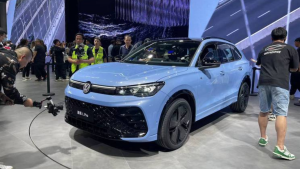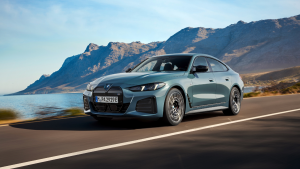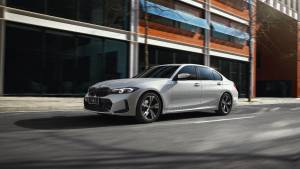Menage a trois
If you watch FTV, one aspect about design that should strike you is that it's an universal language; there really aren't any regional differences. So a designer in Asia will have the same take on a theme as a designer in Paris whose design will not deviate much from what is being presented in Brazil. So a trenchcoat or even lingerie will look the same everywhere. But that's clothes for you. If you had to look at electronics, it's still the same, there are no regional influences. An LED TV designed in China looks the same as one made in Taiwan or the one made in eastern Europe. Almost all goods of modern society are designed without regional influences. That however is not the case in the automobile industry. In the automotive business, each region that is a hub of design and manufacturing exerts its local influence. So cars are distinctly American, German, Italian, Japanese and now yet another major influence is emerging, Korean. Once however everyone in the world ridiculed Hyundai's designs, which no one other than the Koreans themselves thought were brilliant collages. These cars, I'll admit, weren't really great looking but, somehow in various parts of the worlds they worked. Today things have changed for the better. Hyundai has established its own design language devoid of any inspiration, yet with a wholly Korean attitude that is flashy and obtuse to some but pleasing to others. This new design direction is Hyundai's new arsenal in the battle against the rest of the world's automobile manufacturers. And the most recent car armed to the teeth with this arsenal is the new Hyundai Verna. It is making headlines everywhere it goes, it is also making heads turn everywhere. Hyundai's new fluidic design theme is getting infectious but in our world, the world of the critic, does this new design language that touches almost all aspects of the new Verna work against the others in the segment? I have the diesel, Sirish in the subsequent story handles the petrol and to filter the noise, we each run it through layers. In my case the crude has two layers, the recently launched Maruti SX4 diesel and the reigning champion of the masses, the Volkswagen Vento diesel. Does the Verna come clean after passing through these two? EXTERIORS So you know that the Verna has a Korean influence. What you don't know is that's it's not a design I like. But that's me. A whole lot of consumers will appreciate Hyundai's new fluidic design language and what it does for the Verna. The front is a busy area with a lot of undulations, curves, lines and design elements blended together into this rich smorgasbord. But to appreciate this sedan you have to shift your gaze beyond and see the lines that form its three-box shape. Then there is no mistaking that this is a visually appealing profile especially with its unique forward canted stance that makes it look dynamic. The most appealing area to me was the C-pillar which at its base falls close to the boot giving it this notchback a coupe-like silhouette. It's a very strong element and brings to mind the notchback form of the Accent Viva a shape we liked very much. Further behind the tail has the same sense of diversity as the front, lots of curves and heterogeneous accents frame it in an interesting tapestry. In contrast only the Vento is able to hold its ground against the Verna because it still is a bit fresh off the boat while I find its European accents far more appealing. It portrays a sense of solidity and dependability and in several ways that is an attractive enough magnet for prospective buyers. The SX4 on the other hand is old hat, and though the flared out body kit our test car sported gave it an air of sportiness, that dynamism feels as old as Rocky Balboa in his fifth sequel. A bit wrinkled with slight layers of flab accumulating around the edges yet with an aura of strength and ruggedness. INTERIORS The Verna continues the fluidic theme inside the cabin and I quite like the way the dashboard flows into the centre stack and drops deeper into the transmission tunnel. That waterfall effect funnelled towards the floor is a clever design and it allows a lot of space to form in the footwells, so you instantly get this sense of roominess. That said the 2570mm wheelbase ensures there's enough legroom for both front and rear passengers a fact further enhanced by the flat floor at the rear. The rear seats have ideal squab space with enough underthigh support and the backrest is tall enough for you to sink into the seat and not depend on the head rest to provide the last additional bit of support. The seats for the front passengers are also generous though they aren't too supportive. Yet over a long journey they will provide ample comfort and that's more important than how well it tucks in your muffin tops in a hard corner. The dashboard is fairly well thought out and the controls for everything are simple, ergonomic and though the electronics are a bit fidgety, you wouldn't spend more than a couple of minutes familiarizing yourself with the terrain. What I don't like is that it doesn't feel classy nor is it great on quality. By that I mean the details feel inexpensive and built to a price. The fonts are dim and the backlight too garish, the flashy loud types though will quite simply love it! The Vento on the other hand offers more leg and knee room though shoulder space is the only area it feels a bit restricted, this being a reincarnation of a hatchback. Where the Vento finds the additional length for passengers is from the well designed seats especially the rear which in the sedan is pushed deeper into the car. Footwell space however is narrow, the centre console interferes with your knees and the armrest for the front passengers is more intrusive than a benefit. The Vento's seats are also placed lower so ingress and egress is a slight issue. Yet I like the look and feel of the cabin, the dashboard has a sophisticated premium-ness to it, the arrangement is logical, the black on beige tone does not brighten up the cabin but neither is it dull thanks to the slivers of chrome adding some brightness, the rigidly square shapes and textures may be a bit boring but that also allows a sense of consistency in the layout which is soothing. The SX4 in contrast hangs somewhere in between. You know the thick chrome strips and the thick chunky wheel are a thing of the past. The slight bulk the SX4 shows in everything is just so yesterday. Definitely needs an upgrade. Space though is also a bit of an issue. It has the most shoulder space to keep front passengers isolated from each other comfortably though it has the least amount of leg and knee room. Nevertheless the seats are placed the highest so ingress-egress isn't an issue. FEATURES Mildly put the Verna makes the Vento and the SX4 turn red when you start ticking the have from the have-nots on the equipment list. It offers Bluetooth connectivity for cellphone as well as audio streaming. It will accept an aux connection or a memory stick or even hook up to your iPod/iPhone/iPad. It's got a cooled glovebox, a camera assisted parking system with a display located in the inside prismatic rear-view mirror, keyless ignition, audio and telephone connectivity can be accessed from the steering wheel, there's climate control with an ioniser to vent out bad odour and six airbags. Most of these features are however confined to the top-of-the-line variant alone which is very steeply priced. Top variants of neither the Vento nor the SX4 come close to matching that list, though the SX4 at least has an aux port and steering controls for audio unlike the Vento whose bare minimum convenience features in this day and age is quite disappointing. POWERTRAIN You can choose between either a 1.4-litre or a 1.6-litre diesel in the Verna. The engine we analysed was the new 1.6 and it is assisted by a VGT turbocharger unlike a standard turbo in the smaller engine. What the VGT does in this case is provide boost much earlier. In this case the turbo spools at just around 1500rpm and you sense the 260Nm torque surging in at just 1750rpm. Unlike in the older Verna though, this engine is far more sedate yet just as quick to deliver its load. The one grouse we had in the older Verna was that the torque rushed at you like a tidal wave when one moment there was nothing. The new Verna is far more linear in that respect, you don't experience any turbo lag and with a strong bottom end you do get a lot of versatility from this engine without having to constantly play with the 6 forward ratios on its manual transmission. While the torque gives it an effortless character the 128PS max power that peaks at 6300rpm gives it the ability to hold a decent clip when cruising on the highway without losing any efficiency or feeling strained. What I think a lot of people will appreciate most is that this engine, the most powerful in this trio, does not try too hard to do its thing, you don't have to constantly work the gearbox and there is enough torque when you need it, instantly. The Vento also has a 1.6-litre engine displacing 1598cc with a standard turbo. It is a bit more energetic than the Verna because its 250Nm of max torque is generated at 1500rpm, 200rpm before the Verna. That allows it to accelerate with a bit more gusto as well as giving her better driveability in urban areas. Even her maximum 105PS power is available much earlier, at just 4400rpm, which gives her much better low to mid range driving abilities. The 5-speed manual transmission is also nicer and more precise to operate with short throws enhancing its sportiness. The SX4 on the other hand has the smallest diesel in this segment, her 1248cc DDiS engine a carry forward from what is also used in the Swift and Dzire, quite underpowered in this company. It's an engine we've driven extensively and to date it has never ever disappointed us however mated to the SX4 the 1.2 tonne kerb weight does suffocate her a bit. 90PS and 200Nm then really don't feel like much especially when you have to keep coaxing the power and torque out of her by constantly shifting into lower gears. THE NUMBERS The Verna pushes forwards its power and torque advantage to the fullest, clocking a 100kmph in 10.62 seconds. That's a second quicker than the Vento and more than five seconds quicker than the SX4. It however does not feel quick as much as it is smooth. Unlike the Vento its torque surge does not feel as purposeful and you barely realise that the strong bottom and midrange torque is rapidly building momentum. The transmission in the Verna has shorter ratios in the lower gears and this additionally helps it accelerate quickly in a standing start. Third gear onwards the ratios get taller and while this benefits fuel efficiency it also ensures a higher top speed, which in this case we registered at 188kmph. The Vento in comparison can also manage a healthy 182kmph with the SX4 lagging behind at just 170kmph. So given its tremendous acceleration you'd expect the Verna to compromise its fuel efficiency. That however is not the case. On the highway it ran for 23kmpl and in the city 12.42kmpl. That leads to an overall 15.22kmpl and a range of 654km. The Vento though slightly less efficient on the highway makes up for it in the city by posting the best efficiency at 13.3kmpl. The SX4 however isn't a slouch here. Thanks to a well geared transmission it clocks a high 20.19kmpl on the highway and a competitive 12.8kmpl in the city which is better than the Verna's city figure. Overall though the Verna is still the most fuel efficient here, with the Sx4 turning out to be better than the Vento. DYNAMICS & RIDE COMFORT The Verna has the standard suspension set-up with a MacPherson wishbone at the front and a torsion bar at the rear. These work extremely well at isolating rough roads and provide very good ride quality on our road surfaces. Passenger comfort is high up the priority and is optimised for urban areas and once inside the cabin there is no doubt that this the Verna has the best ride quality in this trio. On the highways however the suspension does show its soft side and the required balance and stability is absent, whereas understeer is also quite pronounced. This is further aggravated by the steering which is overservoed, lacks feel and frankly is an absolute disaster. It in fact takes away whatever pleasure you can derive from the car otherwise. In the city the steering feels light and makes maneuvering through tight spaces easy, so parking and traffic are dealt with smoothly. However the same steering unravels on the highways, the lack of two-way communication means that you have no idea of knowing what the steering is telling the wheels to do and vice-versa. Sudden and sharp steering inputs at speed feel very dangerous and with the soft suspension, the immense body roll generated upsets the car. The Verna also has disc brakes all around assisted by ABS with EBD and braking from 100kmph or 80kmph to a complete standstill is executed without any fuss and interestingly without showing any front end dive or the tail stepping out. However the Verna also has the poorest braking distance, no doubt exacerbated by the wooden feel the pedals exhibit. This however is quite possible because the brake pads haven't been bedded down as yet on our barely used test cars. The Vento in that respect is perfectly poised in both city and highway duties though having used it extensively for over a month as my long-termer there are certain traits that I am now realising. There is for instance a fair amount of body roll in this car with a bit of understeer as well, though while cornering it offers a lot more grip and stability a trait that is further enhanced by its precise and finely balanced steering. But what makes the Vento stand out is its high speed stability and composure, cruising on the expressways this car has the feel and maturity of a much a larger, heavier and more substantial car that is firmly planted. The engine, transmission, suspension combination works very well and you do enjoy driving this car more than any other in the segment. The steering on the Vento is brilliant, light in the city and gains weight when the going gets faster, and with just 2.8 turns lock to lock, is comfortable and convenient in the constricted urban areas. Ride quality is also quite impressive on the Vento though not as accomplished as the Verna. Shock absorber damping and recoil feels softer so you experience a lot more travel and therefore some body roll. Nevertheless the shock absorbers are able to adapt to and accommodate all sorts of surfaces well. The SX4 on the other hand is super stiff, not harsh but hard. It also irons out any creases on the road but not without intimating you of every aspect affecting the dampers. Part of this stiffness comes from the slightly larger and lower profile tyres. This stiffer set-up though is a benefit to the handling character and where the Vento feels more flickable with fantastically stable turn in, the Sx4 needs a bit of effort at the wheel. Is it a better handling car than the Vento though well I'm not exactly convinced, because at the end of the day the Sx4 still has this peculiarly heavier and slightly laboured feel. It will go around corners impeccably but just does not seem as eager as the Vento to do so. On the braking front the Vento has better figures than the SX4, both however turning out to be better than the all-disc set-up of the Verna. VERDICT So we don't think the new Verna is a significantly better car than the Vento and the SX4. Its 1.6 diesel engine is an accomplished performer, it is smoother, more refined than before while at the same time quicker than the Vento and the SX4. But how many consumers in this segment are going to be swayed by acceleration as a purchase factor? What they want to see is value and in that respect the Verna is definitely the choice. It's fresh off the boat, it is easily the most fuel efficient and then there's the massively long features list which you just don't get in any other car. And then there's that steering which mildly put just does not encourage spirited driving and for a car whose diesel engine is this capable, we were expecting every other ancillary to support that trait thoroughly. So if a driver's car is what you need the Vento fills that need brilliantly. It's fun, has confident road manners and enjoyable dynamics and it's a car that's well suited to both self driven or chauffeured owners. At Rs 10.61 lakh, it's priced on the steep side especially since the equipment levels are the lowest. The only aspect justifying that price are its European look, feel and build in all areas. No surprises then it still remains our popular choice where diesels are concerned. As for the SX4, well Maruti needs to seriously reconsider whether mating larger cars with small engines makes sense to the consumer. No one doubts that the 1.3 diesel is a fantastic engine but it has its limits and lugging around heavy cars such as the SX4 is not one of them. On the flip side you really don't pay a lot of money to purchase the SX4, you get decent amounts of equipment inside and fuel efficiency as well so the value proposition is fairly high. But it still is third choice.
Starts Rs 9.31 Lakhs
1493cc
Automatic
115
250
-NA-
Starts Rs 8.78 Lakhs
999cc
Automatic
105
175
17.69 Kmpl














